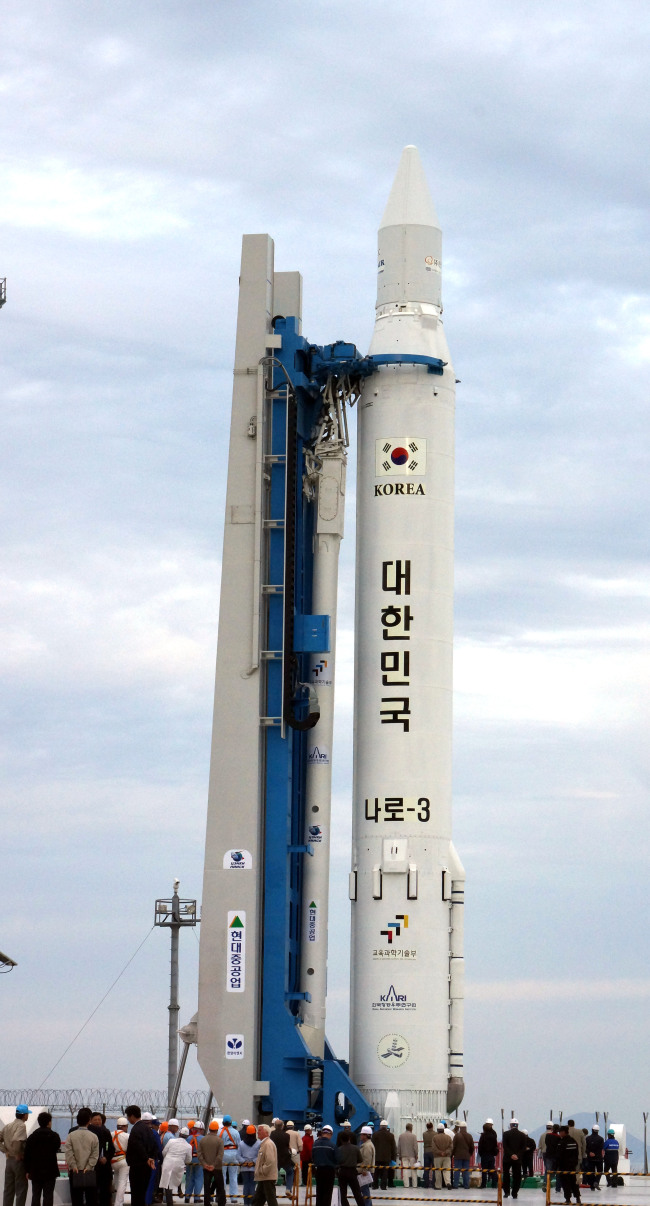Naro rocket ready for launch on Friday
Korea still needs more work to develop proprietary rockets
By Park Hyung-kiPublished : Oct. 24, 2012 - 20:22
Korea has started its countdown for the expected launch of the Korea Space Launch Vehicle-1, also known as the Naro rocket.
There is slight chance of rain on the day of its third attempt to shoot it into space, but officials said the launch schedule remains set for Friday at 3:30 p.m.
This will be the first and last launch of Naro using Russian technology including a liquid-fueled rocket engine, should it succeed.
Korea has an agreement with Russia in which the latter will provide three engines taking into account of the possibility of launch failure, not its rocket propulsion technology. However, Russia has agreed to share design and operational know-how in launch pads with Korea.
There is slight chance of rain on the day of its third attempt to shoot it into space, but officials said the launch schedule remains set for Friday at 3:30 p.m.
This will be the first and last launch of Naro using Russian technology including a liquid-fueled rocket engine, should it succeed.
Korea has an agreement with Russia in which the latter will provide three engines taking into account of the possibility of launch failure, not its rocket propulsion technology. However, Russia has agreed to share design and operational know-how in launch pads with Korea.

The so-called “joint venture” rocket launched purely for scientific purposes has failed to launch twice into space, and everyone ranging from government officials to the public is counting on Naro to make history this Friday.
Experts said that a successful launch will provide a foothold for the country to further develop its proprietary rockets and satellites that can monitor climate change and the environment among other things crucial to the society.
But the country still has a long way to go before it can catch up with other advanced economies ― even China. Korea’s space budget is one-tenth of that of Japan, and one-hundredth of China.
In comparison with automobiles, Korea’s level of space technology is on a par with the Hyundai Pony using foreign engines, said Lee Chang-jin, professor of aerospace engineering at Konkuk University.
“However, Naro would be a stepping stone for Korea to develop indigenous application satellites with our own made-in-Korea rocket engine equivalent to luxury automobiles such as BMW as Korea has sufficiently learned from its past failures,” Lee said.
He added that developing a space program will need time and patience.
Their potential, which may not be noticeable in the near term, should be seen like other industries such as shipbuilding and semiconductors whose success did not happen overnight.
Prof. Chang Young-keun of Korea Aerospace University said that space is all about “trials and errors,” and the next crucial step after the Naro launch is to develop Korea’s domestic rocket propulsion technology.
“That technology will define Korea’s space capability over the next 10 years,” said Chang.
This is the area where South Korea not only lags behind other advanced economies but also North Korea, which already has the know-how in developing liquid rocket engines.
North Korea’s Taepodong missile rockets use liquid engines, which initially pushed South Korea to launch its space and rocket programs.
By Park Hyong-ki (hkp@heraldcorp.com)







![[Weekender] How DDP emerged as an icon of Seoul](http://res.heraldm.com/phpwas/restmb_idxmake.php?idx=644&simg=/content/image/2024/04/25/20240425050915_0.jpg&u=)


![[KH Explains] No more 'Michael' at Kakao Games](http://res.heraldm.com/phpwas/restmb_idxmake.php?idx=644&simg=/content/image/2024/04/28/20240428050183_0.jpg&u=20240428180321)







![[Herald Interview] Mistakes turn into blessings in street performance, director says](http://res.heraldm.com/phpwas/restmb_idxmake.php?idx=652&simg=/content/image/2024/04/28/20240428050150_0.jpg&u=20240428174656)
